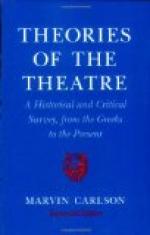Hence the drama, to interest at all, must cater to this longing for contention, which is one of the primordial instincts of the crowd. It must present its characters in some struggle of the wills, whether it be flippant, as in the case of Benedick and Beatrice; or delicate, as in that of Viola and Orsino; or terrible, with Macbeth; or piteous, with Lear. The crowd is more partisan than the individual; and therefore, in following this struggle of the drama, it desires always to take sides. There is no fun in seeing a foot-ball game unless you care about who wins; and there is very little fun in seeing a play unless the dramatist allows you to throw your sympathies on one side or the other of the struggle. Hence, although in actual life both parties to a conflict are often partly right and partly wrong, and it is hard to choose between them, the dramatist usually simplifies the struggle in his plays by throwing the balance of right strongly on one side. Hence, from the ethical standpoint, the simplicity of theatre characters. Desdemona is all innocence, Iago all deviltry. Hence also the conventional heroes and villains of melodrama,—these to be hissed and those to be applauded. Since the crowd is comparatively lacking in the judicial faculty and cannot look upon a play from a detached and disinterested point of view, it is either all for or all against a character; and in either case its judgment is frequently in defiance of the rules of reason. It will hear no word against Camille, though an individual would judge her to be wrong, and it has no sympathy with Pere Duval. It idolizes Raffles, who is a liar and a thief; it shuts its ears to Marion Allardyce, the defender of virtue in Letty. It wants its sympathetic characters, to love; its antipathetic characters, to hate; and it hates and loves them as unreasonably as a savage or a child. The trouble with Hedda Gabler as a play is that it contains not a single personage that the audience can love. The crowd demands those so-called “sympathetic”




